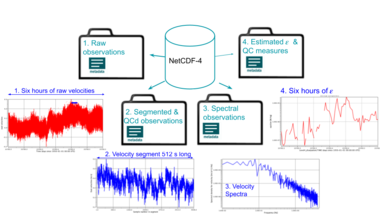NetCDF velocimeters format: Difference between revisions
From Atomix
mNo edit summary |
mNo edit summary |
||
| (14 intermediate revisions by the same user not shown) | |||
| Line 1: | Line 1: | ||
This page provides an overview of the NetCDF format of benchmark dataset for instruments that measure velocities at a point in space e.g., [[Acoustic-Doppler Velocimeters|acoustic-Doppler velocimeters]] and [[Travel-time Velocimeters | travel-time velocimeters]] (MAVS). The NetCDF benchmark format was designed with the goal of facilitating algorithm testing and verification. Minimum requirements for archiving will be discussed at later date. | This page provides an overview of the NetCDF format of benchmark dataset for instruments that measure velocities at a point in space e.g., [[Acoustic-Doppler Velocimeters|acoustic-Doppler velocimeters]] and [[Travel-time Velocimeters | travel-time velocimeters]] (MAVS). The NetCDF benchmark format was designed with the goal of facilitating algorithm testing and verification. Minimum requirements for archiving will be discussed at later date. | ||
== Benchmark dataset format for velocity point-measurements == | == Benchmark dataset format for velocity point-measurements == | ||
ATOMIX provides several benchmark datasets consisting of four processing levels. | ATOMIX provides several benchmark datasets consisting of four processing levels. | ||
[[File:Benchmark adv netcdf.png|380px|thumb|Layout of NetCDF-4 benchmark dataset. The groupings are intended as checkpoints for algorithm testing.]] | |||
# [[Level 1 data (velocity point-measurements)|Raw timeseries]] | # [[Level 1 data (velocity point-measurements)|Raw timeseries]] | ||
#* full resolution data in physical units | #* full resolution data in physical units including quality-control flags | ||
# [[Level 2 data (velocity point-measurements)|Quality-controlled and segmented timeseries]] | # [[Level 2 data (velocity point-measurements)|Quality-controlled and segmented timeseries]] | ||
#* [[Detrending time series|Detrended]] and subdivided further in individual [[Segmenting datasets|segments]]. | #* [[Detrending time series|Detrended]] and subdivided further in individual [[Segmenting datasets|segments]]. | ||
# [[Level 3 data (velocity point-measurements)| | # [[Level 3 data (velocity point-measurements)|Spectral observations]] | ||
#* raw and cleaned (if | #* raw and cleaned (if applicable) spectra | ||
# [[Level 4 data (velocity point-measurements)|Dissipation <math>\varepsilon</math> estimates]] | # [[Level 4 data (velocity point-measurements)|Dissipation <math>\varepsilon</math> estimates]] | ||
#* dissipation estimates and corresponding quality parameter as time series | #* dissipation estimates and corresponding quality parameter as time series | ||
---- | |||
Return to [[Velocity point-measurements]] | |||
[[Category: Velocity point-measurements]] | [[Category: Velocity point-measurements]] | ||
Latest revision as of 15:12, 7 March 2022
This page provides an overview of the NetCDF format of benchmark dataset for instruments that measure velocities at a point in space e.g., acoustic-Doppler velocimeters and travel-time velocimeters (MAVS). The NetCDF benchmark format was designed with the goal of facilitating algorithm testing and verification. Minimum requirements for archiving will be discussed at later date.
Benchmark dataset format for velocity point-measurements
ATOMIX provides several benchmark datasets consisting of four processing levels.

- Raw timeseries
- full resolution data in physical units including quality-control flags
- Quality-controlled and segmented timeseries
- Spectral observations
- raw and cleaned (if applicable) spectra
- Dissipation <math>\varepsilon</math> estimates
- dissipation estimates and corresponding quality parameter as time series
Return to Velocity point-measurements
